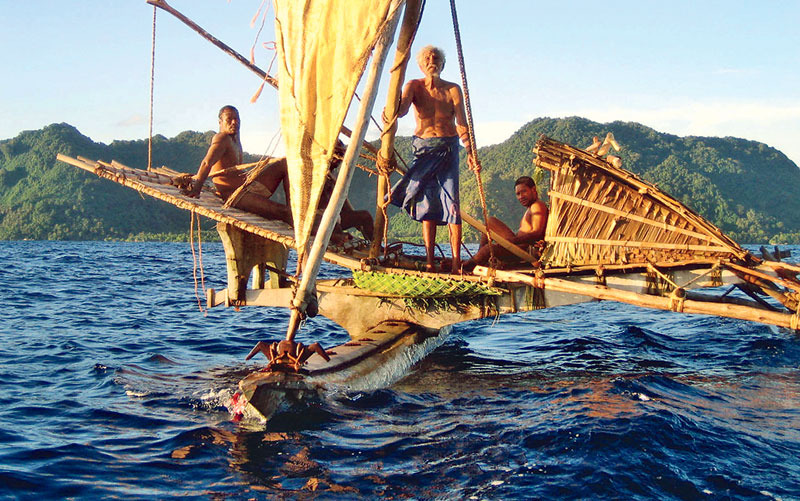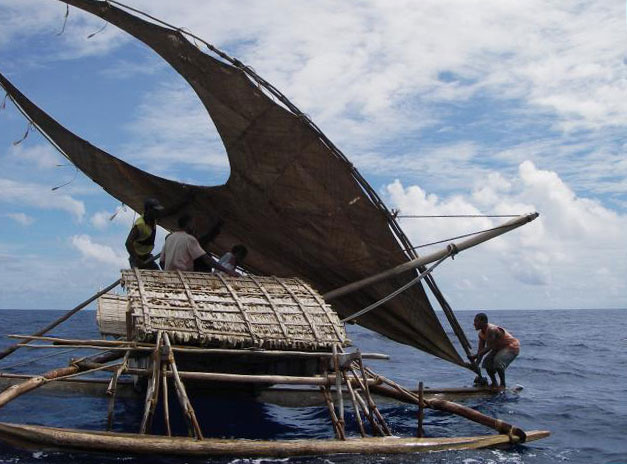
We the Voyagers
On Wednesday, a sneak peek of the documentary We the Voyagers will be screened at the San Francisco Yacht Club. The film is part of the Vaka Taumako Project, a nonprofit centered on Taumako Island in the Duff Islands group, in the Solomons. The project "aims to perpetuate ancient Polynesian seafaring knowledge and practice by training a new generation of Taumako youth to build, sail, and navigate using the ancient methods, materials, and tools used by their ancestors." The project also documents the building and sailing of voyaging canoes known as Vaka o Latas (which are named after the ancient Polynesian culture hero Lata).
We were at a sneak peak of We the Voyagers back in April at the Dolphin Club, where we met the film’s principal investigator Mimi George — a sailor and anthropologist — whom we wrote about in the August issue’s Sightings. While she was a pre-med student on the East Coast, George read David Lewis’s seminal book We the Navigators, which changed the course of Mimi’s studies; she has spent her career studying ancient voyaging cultures.

Polynesian-inspired non-instrument voyaging has had something of a resurgence in the last few decades. In 1975, the Polynesian Voyaging Society built the Hokule’a, a fiberglass twin-hulled, 61-ft wa’a, or voyaging canoe. The Hokule’a has since circumnavigated the globe, and has trained navigators in non-instrument wayfinding. In 2016, the New York Times wrote an extensive piece about "wave pilots" in the Marshall Islands attempting to pass on their secret craft to a new generation. There was also a modern-day angle to that particular exhibition: An anthropologist, physicist and oceanographer joined traditional navigator Alson Kelen on an interisland voyage in the hopes that he could help them explain "how wave pilots, in defiance of the dizzying complexities of fluid dynamics, detect direction and proximity to land. More broadly, they wondered if watching him sail, in the context of growing concerns about the neurological effects of navigation-by-smartphone, would yield hints about how our orienteering skills influence our sense of place, our sense of home, even our sense of self," wrote Kim Tingley in the Times.
There’s been another seemingly unlikely force perpetuating Polynesian voyaging: That’s right, the Disney/Pixar musical Moana. "As someone who lectures on traditional oceanic navigation and migration, I can say resoundingly that it is high time the rest of the world learned this amazing story," wrote geographer Doug Herman, who specializes in the cultural knowledge of Hawaii and Pacific islands, in Smithsonian Magazine. Herman also criticized the film for some inaccuracies, and for perpetuating insensitive tropes about Polynesians. Speaking about the Vaka Taumako Project, Mimi wrote: "An isolated Polynesian community uses ancient voyaging skills to reconnect with ancestral partners on distant islands. Everyone is part of this real Moana." (Yes, the Latitude Movie Club will be reviewing Moana in an upcoming ‘Lectronic.)

The Polynesians don’t have the same foothold in history as Columbus, Drake or Magellan. There is virtually no documentation or history of their maritime society; there were no portraits painted of them, and they have no models or drawings equivalent to the Niña, Pinta, or Santa Maria to be revered by school children. But the power of a culture that populated two thirds of the planet cannot be denied. "The colonization of Pacific Islands is the greatest human adventure story of all time," said Herman. "People using Stone Age technology built voyaging canoes capable of traveling thousands of miles, then set forth against the winds and currents to find tiny dots of land in the midst of the largest ocean on Earth. And having found them, they traveled back and forth, again and again, to settle them 500 to 1,000 years ago."
